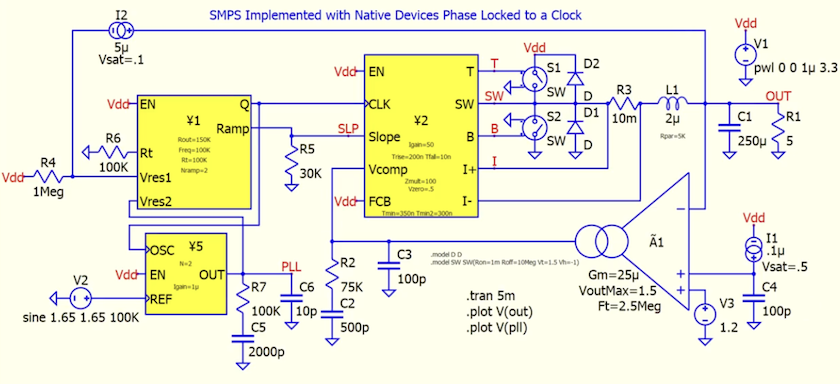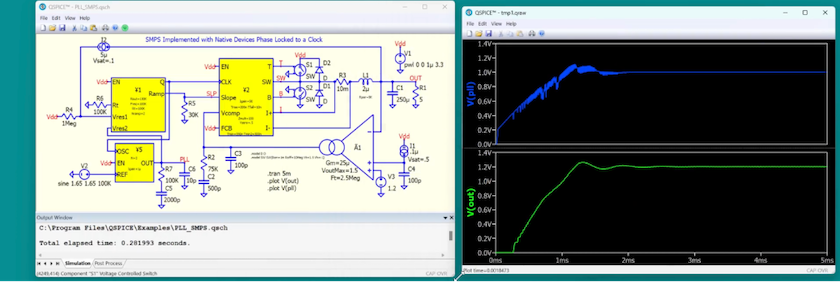A Much Spicier SPICE: Free & Fast Circuit Simulation for Mixed Analog and Digital
October 5, 2023
As new improvements were made and iterations released, the public domain software gained popularity among design engineers. So much so that it was often used as a verb, “I’m going to SPICE this circuit.” Much like, “Let me Google that information.”
SPICE is still in full swing today, including numerous commercial and open-source derivatives such as LTSPICE, PSPICE and NGSPICE. And now there’s an even faster, more robust, reliable and comprehensive (hint: mixed-signal) free version available: the Qorvo QSPICE® simulator for RF and power circuits.
Qorvo’s Technical Marketing Manager, David Schnaufer, sat down with Mike Engelhardt, creator of QSPICE (and LTSPICE), and Jeff Strang, Qorvo’s General Manager of Power Management, to learn about the significance of QSPICE for the design engineer community.
Q: There have been quite a few versions of SPICE simulation software developed over the years. How is Qorvo’s QSPICE different from the others?
Jeff Strang: It’s important to note that QSPICE was built from the ground up—a rewrite of the SPICE code—to include better SPICE basics. One of the key differentiators is that it offers mixed-signal simulation. It supports a massive amount of digital circuit networks—a paramount advancement for SPICE simulators. The inclusion of digital was done with the power engineer in mind – to provide them with the ability to simulate circuits and systems that combine RF that can handle high-power levels while preserving RF performance, efficiency and reliability.
In addition, users can write C++ or Verilog source code into native object code, which enables faster and more efficient execution of the simulation, potentially allowing for larger and more complex simulations to be performed within reasonable timeframes.
- Fast: The world’s most advanced SPICE engine plus digital (mixed-mode) simulation
- Flexible: No feature limitations
- Free: Free for everyone with no model restrictions
Lastly, it has a more modern GUI that is very intuitive and offers a graphical circuit view, allowing users to easily create and edit circuits.

Q: What is the significance of QSPICE for today’s design community?
Mike Englehardt: In the past, power designers relied on analog circuits and silicon power switches. Today, digital control and compound semiconductors are common elements of advanced power designs. Whether an engineer is developing AI algorithms for EV battery charging, optimizing a Qorvo pulsed-radar power supply or evaluating our newest silicon carbide FETs, QSPICE is an ideal platform for their innovation.
Q: What is meant by “better SPICE basics?”
Mike: These improvements lead to increased simulation speed and accuracy. One is the removal of device I-V discontinuities, which allows for faster simulations. And to improve the accuracy, we’ve included detailed transistor models for superior transistor-level simulation, as well as a completely rearchitected error-based, adaptive time-step control.

Q: Where are the simulations run? In the cloud or locally?
Mike: The software comprises multiple executable programs that handle pattern acquisition, simulation, waveform display and post-processing—all of which are run locally. The primary program, QUX.exe, calls upon the other executables as required. It runs on Windows PCs with GPU accelerators for high-quality, real-time graphics.
It can also be run air-gapped—a security measure used to isolate the user’s computer or network from external connections, particularly from the internet or other potentially untrusted networks, to prevent unauthorized access. This allows usage in highly sensitive environments, such as the military, government, financial institutions, research laboratories and certain industrial control systems.
Q: What are the limitations of QSPICE?
Mike: There are no artificial limitations on circuit size or complexity and no restrictions on importing, exporting or measuring. Because QSPICE is written to Intel object code, it runs as fast as any program on your computer. Therefore, the only limitation is the horsepower of the user’s computer.
Q: What models does it include?
Mike: Models include Qorvo’s silicon carbide (SiC) products and many other Qorvo power products, with a portfolio that is continually updated. Models for new Qorvo power management solutions will be included with QSPICE updates, making it easy for customers to evaluate and design with Qorvo power. Updates will be delivered to QSPICE users upon startup of the tool.
Users can also create their own models and integrate them into the software and third-party models can easily be imported. We made a video showing just how easy it is to add these additional models.
Q: Who can use QSPICE?
Jeff: It is open to anyone and everyone. Other IC manufacturers can offer proprietary encrypted models to run on it. The semiconductor community is welcome to standardize on QSPICE.
Q: How is it being received so far?
Jeff: Very well. We’ve conducted a beta test with more than 1,000 users. Here are what a few of them are saying:
‘Better, stronger, faster! The six-million-dollar simulator: QSPICE! Spice has been upgraded to its highest level, I think. QSPICE is a very nice tool that I thank you and Qorvo for offering.’
I would like to extend my heartfelt congratulations on your outstanding software. It is truly remarkable how fast and intuitive it is, making it a valuable tool for students, professionals, and enthusiasts in the field. Its speed and intuitiveness have undoubtedly significantly impacted the productivity and efficiency of users in electrical engineering. I would like to commend you on the exceptional quality of your software.
My compliments to the team. As an experienced SPICE user, I had no problems with my first experience using QSPICE. The GUI is intuitively easy. I appreciate the elimination of fcn-N keystrokes to activate selection tools, and I’m happy to see that all new windows are always floating.
Q: Where is QSPICE available?
Jeff: QSPICE is available exclusively from Qorvo. You can register to download it with a valid email address here here.
Q: Does Qorvo have other design tools that complement QSPICE?
Jeff: QSPICE is another electronic engineering design instrument to add to your arsenal of design tools. With Qorvo as your design partner, you can be assured of receiving superior hands-on design services and free system-level design tools. Our tools, some of which are listed below, can be used to help you easily and efficiently complete your design.
- RF-based interactive tools and calculators, including MatchCalc™ are all freely available online in Qorvo’s Design Hub. MatchCalc is a free downloadable RF tool similar to ADS or NI/AWR Microwave Office, is capable of a wide range of matching tasks in the design of RF components and systems. Easily matches RF chain S1P and S2P files.
- FET-Jet Calculator – helps evaluate and identify SiC FET devices for power applications. It also supports 26 unique power topologies providing results to quickly facilitate fundamental design decisions.
- Modelithics is Qorvo’s GaN model library, which contains high-accuracy nonlinear simulation models for Qorvo GaN transistors.
- Keysight Model Library – this library contains models for select Qorvo products in a downloadable library for use with Keysight’s PathWave System Design (SystemVue) or PathWave RF Synthesis (Genesys).
Learn more about QSPICE in the Qorvo Tech Forum, where early adopters and QSPICE creator Mike Engelhardt discuss the specifics of the simulator. Hear from QSPICE creator Mike Engelhardt about what you can expect from QSPICE.
Have another topic that you would like Qorvo experts to cover? Email your suggestions to the Qorvo Blog team and it could be featured in an upcoming post. Please include your contact information in the body of the email.

